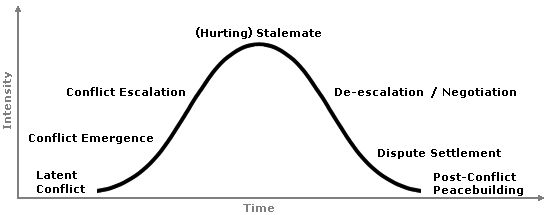Another way to analyze the issues of a conflict is to understand the stage the conflict is at and the stages it has gone through. Every story you have ever heard has a plot and conflict that drives the story forward. The plot shows the story going through a series of phases, as shown in the following plot diagram:
Real-life conflicts also go through a similar series of phases that are commonly depicted, as shown in the following image.

Image from Beyond Intractability, https://beyondintractability.org/essay/conflict_stages
Note, however, that the progress from one stage to the next is not smooth, and conflicts may repeat stages several times.
The conflict stages are a way of understanding how conflicts develop and evolve over time. They include:
- Latent conflict: In this stage, the parties have differences that bother at least one party, but those differences are not significant enough to cause them to act to change the situation. The seeds of conflict are present, but the situation can remain latent until emergence.
- Emergence: In this stage, the issues have grown in significance, the grievances or frustrations are strong enough, and a triggering event marks the beginning of the active conflict, as parties begin to openly express their disagreement or opposition to one another. For example, a labor union may hold a strike to protest against their employer’s proposed changes to their contract.
- Escalation: The conflict becomes more intense and severe as the parties take increasingly strong actions to assert their positions. For example, in a war, the use of weapons and the number of casualties increase.
- Hurting stalemate: The conflict reaches a point where both sides are suffering, and neither can achieve their goals. A stalemate is a situation in which neither party can win, but neither party wants to back down or accept defeat either. For example, in a trade dispute, both countries are imposing tariffs on each other’s goods, but neither side is able to force the other to back down.
- De-escalation. De-escalation is the process of reducing the level of tension and hostility in a conflict. It involves finding ways to calm down the situation and bring opposing sides to a more peaceful state. It may involve two brothers who have been in a strong family fight that has divided the family, deciding to stop fighting, sit down and talk through their differences.
- Settlement: The parties reach an agreement to resolve the conflict. For example, in a negotiation, both sides come to a compromise on the terms of their contract.
- Post-conflict peacebuilding: This stage involves rebuilding and repairing the damage caused by the conflict. For example, in the aftermath of a civil war, the government may focus on rebuilding infrastructure and promoting reconciliation between different groups.
- Resolution: This is the final stage where the conflict is fully resolved and the parties can move on. In this stage, the root causes of the conflict are addressed, and the parties are able to coexist peacefully.
It’s worth noting that conflicts can also move backward through these stages. For example, a settlement can unravel, and the conflict can escalate again. Conflict also can have different stages at the same time for different actors involved. For example, one party may be at the hurting stalemate stage while the other is at the escalation stage.[i]
[i] If you would like further reading on conflict stages, please visit beyondintractibility.com They have an excellent article on conflict stages. https://www.beyondintractability.org/essay/conflict_stages

